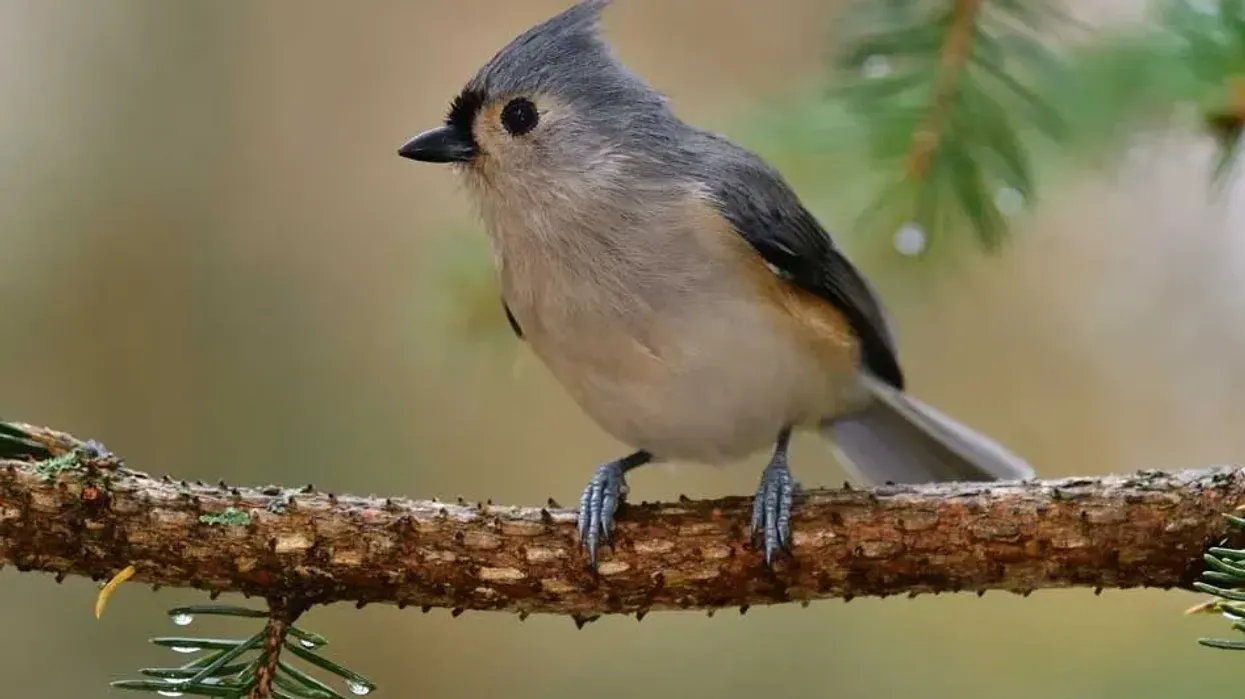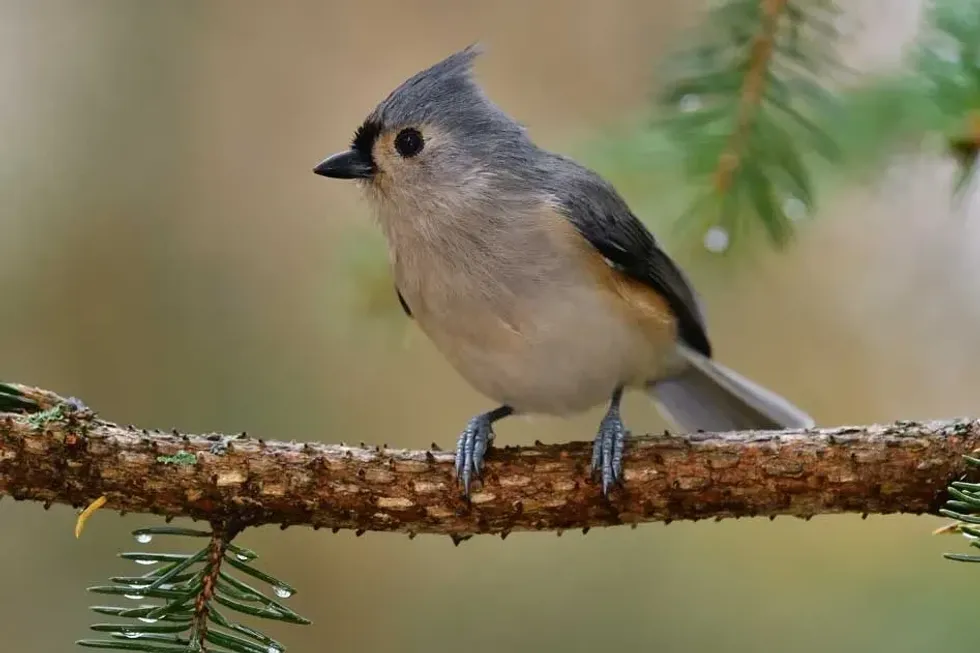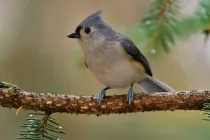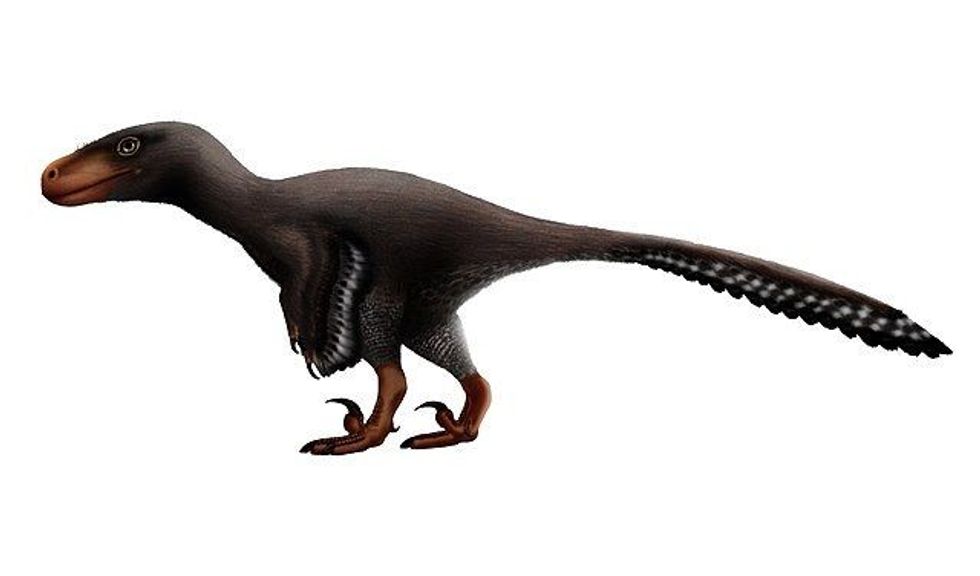The titmouse or the Baeolophus is a genus of birds belonging to the Paridae family. The genus name Baeolophus translates to small-crested. These birds belong to the order Passeriformes which includes perching birds and songbirds. Titmice regularly frequent bird feeders to feast on seeds.
Although the range of the species of titmouse varies, all species of the titmice are native to North America. The genus of titmouse (Baeolophus) comprises the following five species: the Black crested titmouse (Baeolophus atricristatus), Oak titmouse (Baeolophus inornatus), Bridled titmouse (Baeolophus wollweberi), Tufted titmouse (Baeolophus bicolor), and Juniper titmouse (Baeolophus ridgwayi).
This article includes information on the titmouse call, titmouse surviving the winter time, titmouse family order, and much more.
For more relatable content, check out these bowerbird facts and secretary bird facts for kids.
Titmouse Interesting Facts
What type of animal is a titmouse?
The titmouse, also known as Baeolophus, is a type of small songbird native to the North American continent.
What class of animal does a titmouse belong to?
The titmouse (Baeolophus) belongs to the class Aves.
How many titmice are there in the world?
Although there are no estimates available regarding the overall population of titmice, their numbers have been observed to be relatively stable. Moreover, an increase of 1.5% per year has been noted in the population of the tufted titmouse (Baeolophus bicolor) between 1966-2015.
Where does a titmouse live?
All species of the titmice are North American natives. These birds can be found in a variety of natural habitats such as deciduous forests and woodlands. They usually prefer mixed woodlands under 2000 ft (609.6 m) elevation. Apart from that, these birds can also be found in parks and gardens.
What is a titmouse's habitat?
The natural habitat of the titmouse is in holes or cavities in trees in deciduous forests and woodlands. Since the titmouse bird cannot carve out holes in tree trunks, it often takes residence in natural cavities in trees or sometimes in an old woodpecker's nest.
Due to human encroachment into the natural habitat of the titmouse, these birds have started inhabiting parks and gardens.
Along with the chickadee, the titmouse is a regular visitor at bird feeders. These birds have also been known to make themselves at home in human-made nest boxes.
Who do titmice live with?
Titmouse birds live in pairs during their breeding season. However, during the winter months, they have been observed foraging in small mixed flocks.
How long does a titmouse live?
Although many titmice die as hatchlings, the ones that reach adulthood have been observed to have an average lifespan of about 2.1 years.
How do they reproduce?
Although the titmouse forages in mixed flocks during the winter months, these birds become very territorial during their breeding season and will chase away any titmice that attempt to trespass onto its territory.
Titmice make cup-shaped nests in holes or cavities in trees. Since these birds can't excavate tree cavities themselves, they often use old woodpecker nests. They also use human-made nest boxes.
After choosing a suitable location, both parents work together to line the nest with soft materials such as hair, fur, wool, and cotton. They may even pluck hair from living mammals. Titmice also line their nests with shed snakeskins. Some experts speculate, that the snakeskin acts as a deterrent against predators looking to prey on their young.
Once the titmouse nest has been prepared, the females lay their clutch of eggs. The number of titmouse eggs in a clutch may vary from anywhere between three and nine eggs depending on the species.
The eggs of the titmice are approximately 1 in (2.5 cm) long. The eggs are whitish or cream-colored and covered all over with reddish, brown, or purple spots.
The eggs hatch after about 12-14 days of incubation. The hatchlings of the titmice are extremely vulnerable to predation.
During the early days, the mother stays with the young while the father goes to fetch food. Both parents play a vital role in raising the young. Many times the titmouse fledglings that have recently learned to fly have been observed to stay back in order to assist their parents with raising the next year's young.
What is their conservation status?
The International Union for Conservation of Nature (IUCN) classifies the tufted titmouse's conservation status under the category of Least Concern. Even though they face the threat of predation from house cats, birds of prey, snakes, and various mammals, their population is quite stable.
Titmice are fairly abundant across North America. The population of the tufted titmice has consistently increased by 1.5% per year since the 1960s.
Titmouse Fun Facts
What do titmice look like?
The tufted titmouse (Baeolophus bicolor) are gray on top with a white front and rust-colored outline. Perhaps, the most defining feature of the tufted titmice is its prominent tufted gray mohawk.
How cute are they?
Nearly all species of titmice have an extremely cute and adorable appearance.
How do they communicate?
Titmice are songbirds. The titmouse song varies depending on the species. Tufted titmice communicate using a variety of repetitive or chant-like songs. Their song is best described as a whistled 'peter-peter-peter.' Their song can vary in almost 20 different notable ways.
How big is a titmouse?
Titmice are extremely small birds, even smaller than sparrows. Adult tufted titmice are 5.5-6.3 in (14-16 cm) in length with a wingspan of 7.9-10.2 in (20-26 cm). They are nearly four times smaller than a Mallard duck.
How fast can a titmouse fly?
The average flight speed of titmouse is about 10-12 mph (16.1-19.3 kph).
How much does a titmouse weigh?
Titmice are extremely lightweight and weigh less than an ounce. The average weight of adult tufted titmice has been observed to be in the range of 0.6-0.9 oz (17-25.5 g).
What are the male and female names of the species?
The common nomenclature used to distinguish between the gender of the titmouse is male and female. Moreover, titmice do not exhibit sexual dimorphism, this means that both the male and the female exhibit similar characteristics except for their sexual organs.
What would you call a baby titmouse?
Like most members of the class Aves, a young titmouse upon hatching from its egg is called a hatchling. Once the hatchling grows up and leaves the nest, it is known as a fledgling.
What do they eat?
Titmice are omnivorous birds. In the summer months, their diet consists of insects like caterpillars, beetles, ants, and wasps. They also feast on snails and spiders. Titmice also eat seeds, acorns, nuts, berries, and beechnuts. Titmice have been observed to regularly frequent bird feeders.
Are they dangerous?
Titmice do not pose much of a threat to human beings and regularly visit bird feeders to feast on seeds. Although they have been known to promptly respond to calls of agitation from other birds by coming close to investigate and even joining other birds in mobbing a predator.
Would they make a good pet?
Even though titmice are wild birds, with enough patience and persistence, it is possible to befriend them. You can attract these birds by building nest boxes in your backyard or installing bird feeders.
Did you know...
Titmice are diurnal and not active after sundown.
A group of titmice is called banditry.
Although the juniper titmouse and oak titmouse appear to be similar species, the two differ in both voice as well as range.
The black-crested titmouse was previously considered to be a subspecies of the tufted titmouse. Although these two appear to be similar species, in 2002 the black-crested titmouse was recognized as a separate species.
Although most species of the titmouse do not exhibit sexual dimorphism, the male black-crested titmouse has a noticeably darker crest compared to the female.
Why is a titmouse called a titmouse?
The name titmouse is derived from two following Old English words, 'tit' meaning small and 'mase' meaning bird. Hence, titmouse means small bird. The plural of titmouse is titmice.
Is a chickadee a titmouse?
No, chickadees are not the same as titmice. Even though both these birds are members of the Paridae family and these cousins share a lot of similarities, chickadees can be distinguished by their call which sounds quite like their name 'chick-a-dee-dee-dee.'
There are some notable differences between the appearances of chickadees and titmice as well, such as the tufted crest.
Here at Kidadl, we have carefully created lots of interesting family-friendly animal facts for everyone to discover! Learn more about some other birds from our Gila woodpecker facts and southern royal albatross facts pages.
You can even occupy yourself at home by coloring in one of our Titmouse coloring pages.









